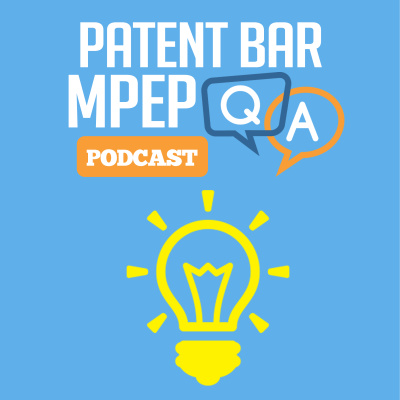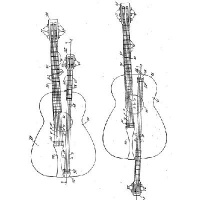Synopsis
Patent Bar Review
Episodes
-
MPEP Q & A 299: What should a motion to exclude evidence include?
09/04/2024 Duration: 03minQuestion: What should a motion to exclude evidence include? Answer: A motion to exclude evidence should: (a) Identify where in the record the objection originally was made; (b) Identify where in the record the evidence sought to be excluded was relied upon by an opponent; (c) Address objections to exhibits in numerical order; and (d) Explain the basis and grounds for each objection. A motion to exclude must explain why the evidence is not admissible (e.g., relevance or hearsay) but may not be used to challenge the sufficiency of the evidence to prove a particular fact. A motion to exclude… The post MPEP Q & A 299: What should a motion to exclude evidence include? appeared first on Patent Education Series.
-
MPEP Q & A 298: Submission requirements for “Sequence Listing XML”
26/03/2024 Duration: 03minQuestion: A “Sequence Listing XML” may be submitted as a XML file with a “.xml” extension via the USPTO patent electronic filing system or as read-only optical discs. What does such a submission require? Answer: Such submission requires that applicant provide a statement in a separate paragraph that incorporates by reference the material in the XML file identifying the name of the XML file, the date of creation, and the size of the XML file in bytes (except that an incorporation by reference statement is not required for a sequence listing properly submitted as an XML file in an international… The post MPEP Q & A 298: Submission requirements for “Sequence Listing XML” appeared first on Patent Education Series.
-
MPEP Q & A 297: List two situations where a certificate of correction may not be appropriate.
12/03/2024 Duration: 03minQuestion: List two exemplary situations where a certificate of correction under 35 U.S.C. 255 may not be appropriate. Answer: Exemplary situations where a certificate of correction under 35 U.S.C. 255 may not be appropriate: (A) Adding or correcting a claim to a prior application having a filing date before March 16, 2013 in a patent that was examined (as indicated on the Notice of Allowance or a later Office communication such as a supplemental Notice of Allowance) under the first inventor to file provisions of the AIA and where the 37 CFR 1.55/78statement is not present. (B) Correcting a claim to a prior application having… The post MPEP Q & A 297: List two situations where a certificate of correction may not be appropriate. appeared first on Patent Education Series.
-
MPEP Q & A 296: List the criteria for “Large Tables”
27/02/2024 Duration: 02minQuestion: List the criteria for “Large Tables” that may be submitted in electronic form in ASCII plain text. Answer: “Large Tables” that may be submitted in electronic form in ASCII plain text are: any individual table that is more than 50 pages in length, or multiple tables, if the total number of pages of all the tables in an application exceeds 100 pages in length. Chapter Details: The answer to this question can be found in chapter 600 of the MPEP. This chapter covers Parts, Form, and Content of Application. The answer is from the 9th Edition, Revision 07.2022, Published… The post MPEP Q & A 296: List the criteria for “Large Tables” appeared first on Patent Education Series.
-
MPEP Q & A 295: Which of the new trial proceedings can the patent owner file a preliminary response for?
13/02/2024 Duration: 02minQuestion: Which of the following new trial proceedings can the patent owner file a preliminary response for? Answer: The patent owner is afforded an opportunity to file a preliminary response for inter partes review (IPR), postgrant review (PGR), and covered business method patents (CBM). Chapter Details: This question comes from the following supplement “Patent Trial and Appeal Board Consolidated Trial Practice Guide November 2019”. This is a special supplement that at the time of this recording is currently being tested on the Patent Bar exam. Depending on future changes to the supplement and the MPEP, the question and answer may… The post MPEP Q & A 295: Which of the new trial proceedings can the patent owner file a preliminary response for? appeared first on Patent Education Series.
-
MPEP Q & A 294: What are the two aspects every requirement to restrict has?
30/01/2024 Duration: 02minQuestion: What are the two aspects every requirement to restrict has? Answer: Every requirement to restrict has two aspects: the reasons (as distinguished from the mere statement of conclusion) why each invention as claimedis either independent or distinct from the other(s); and the reasons why there would be a serious search and/or examination burden on the examiner if restriction is not required, i.e., the reasons for insisting upon restriction therebetween as set forth in MPEP 800. Chapter Details: The answer to this question can be found in chapter 800 of the MPEP. This chapter covers Restriction in Applications Filed Under… The post MPEP Q & A 294: What are the two aspects every requirement to restrict has? appeared first on Patent Education Series.
-
MPEP Q & A 293: Who conducts derivation proceedings, inter partes reviews, and post-grant reviews?
16/01/2024 Duration: 02minQuestion: Who conducts derivation proceedings, inter partes reviews, and post-grant reviews? Answer: The Board is to conduct derivation proceedings, inter partes reviews, and post-grant reviews. Chapter Details: This question comes from the following supplement “Patent Trial and Appeal Board Consolidated Trial Practice Guide November 2019”. This is a special supplement that at the time of this recording is currently being tested on the Patent Bar exam. Depending on future changes to the supplement and the MPEP, the question and answer may not be applicable. Section Summary: This question comes from the following supplement: “Patent Trial and Appeal Board Consolidated Trial… The post MPEP Q & A 293: Who conducts derivation proceedings, inter partes reviews, and post-grant reviews? appeared first on Patent Education Series.
-
MPEP Q & A 292: Two changes the Hague Agreement Article 16(1) provides
02/01/2024 Duration: 03minQuestion: List two changes the Hague Agreement Article 16(1) provides for in the International Register by the International Bureau. Answer: Hague Agreement Article 16(1) provides for the recording of certain changes in the International Register by the International Bureau, including: a change in ownership of the international registration; a change in the name or address of the holder; an appointment of a representative of the applicant or holder; a renunciation of the international registration with respect to any or all of the designated Contracting Parties; a limitation of the international registration with respect to any or all of the designated… The post MPEP Q & A 292: Two changes the Hague Agreement Article 16(1) provides appeared first on Patent Education Series.
-
MPEP Q & A 291: When did the derivation rules go into effect?
19/12/2023 Duration: 02minQuestion: When did the derivation rules go into effect? Answer: The derivation rules went into effect 18 months after AIA enactment (March 16, 2013). Chapter Details: This question comes from the following supplement “Patent Trial and Appeal Board Consolidated Trial Practice Guide November 2019”. This is a special supplement that at the time of this recording is currently being tested on the Patent Bar exam. Depending on future changes to the supplement and the MPEP, the question and answer may not be applicable. Section Summary: This question comes from the following supplement: “Patent Trial and Appeal Board Consolidated Trial Practice… The post MPEP Q & A 291: When did the derivation rules go into effect? appeared first on Patent Education Series.
-
MPEP Q & A 290: Use of metric system of measurements in patent applications
05/12/2023 Duration: 03minQuestion: How should measurements be given within a patent application? Answer: In order to minimize the necessity in the future for converting dimensions given in the English system of measurements to the metric system of measurements when using printed patents as research and prior art search documents, all patent applicants should use the metric (S.I.) units followed by the equivalent English units when describing their inventions in the specifications of patent applications. Chapter Details: The answer to this question can be found in chapter 600 of the MPEP. This chapter covers Parts, Form, and Content of Application. The answer is… The post MPEP Q & A 290: Use of metric system of measurements in patent applications appeared first on Patent Education Series.
-
MPEP Q & A 289: List two situations that are not considered new grounds of rejection?
21/11/2023 Duration: 03minQuestion: List two situations that are not considered new grounds of rejection? Answer: Where the statutory basis for the rejection remains the same, and the evidence relied upon in support of the rejection remains the same, a change in the discussion of, or rationale in support of, the rejection does not necessarily constitute a new ground of rejection. In addition, if: (A) an amendment under 37 CFR 1.116 [or41.33] proposes to add or amend one or more claims; (B) appellant was advised (through an advisory action) that the amendment would be entered for purposes of appeal; and (C) the advisory… The post MPEP Q & A 289: List two situations that are not considered new grounds of rejection? appeared first on Patent Education Series.
-
MPEP Q & A 288: How may an examiner treat an amendment not fully responsive to a non-final Office action?
07/11/2023 Duration: 03minQuestion: How may an examiner treat an amendment not fully responsive to a non-final Office action? Answer: An examiner may treat an amendment not fully responsive to a non-final Office action by: (A) accepting the amendment as an adequate reply to the non-final Office action to avoid abandonment under 35 U.S.C. 133 and 37 CFR1.135; (B) notifying the applicant that the reply must be completed within the remaining period for reply to the non-final Office action (or within any extension pursuant to 37 CFR 1.136(a)) to avoid abandonment; or (C) setting a new time period for applicant to complete the… The post MPEP Q & A 288: How may an examiner treat an amendment not fully responsive to a non-final Office action? appeared first on Patent Education Series.
-
MPEP Q & A 287: When inconsistent information is given for an application data sheet, what submission will govern control?
24/10/2023 Duration: 03minQuestion: When inconsistent information is given for an application data sheet, what submission will govern control according to 37 CFR 1.76(d)(1)? Answer: 37 CFR 1.76(d)(1) provides that the most recent submission will govern (control) with respect to inconsistencies as between the information provided in an application data sheet, a designation of a correspondence address, or by the inventor’s oath or declaration, except that: (1) the most recent application data sheet will govern with respect to foreign priority or domestic benefit claims; and (2) the naming of the inventorship is governed by 37 CFR 1.41 and changes to inventorship or the… The post MPEP Q & A 287: When inconsistent information is given for an application data sheet, what submission will govern control? appeared first on Patent Education Series.
-
MPEP Q & A 286: What are the factual inquiries of obviousness enunciated by the Court?
10/10/2023 Duration: 04minQuestion: What are the factual inquiries of obviousness enunciated by the Court? Answer: Obviousness is a question of law based on underlying factual inquiries. The factual inquiries enunciated by the Court are as follows: (A) Determining the scope and content of the prior art; (B) Ascertaining the differences between the claimed invention and the prior art; and (C) Resolving the level of ordinary skill in the pertinent art. Chapter Details: The answer to this question can be found in chapter 2100 of the MPEP. This chapter covers Patentability. The answer is from the 9th Edition, Revision 10.2019. Depending on future… The post MPEP Q & A 286: What are the factual inquiries of obviousness enunciated by the Court? appeared first on Patent Education Series.
-
MPEP Q & A 285: What don’t the provisions of 37 CFR 1.114 apply to?
26/09/2023 Duration: 03minQuestion: What do the provisions of 37 CFR 1.114, request for continued examination, not apply to? Answer: The provisions of 27 CFR 1.114, Request for continued examination, do not apply to: (1) A provisional application; (2) An application for a utility or plant patent filed under 35 U.S.C. 111(a) before June 8, 1995; (3) An international application filed under 35 U.S.C.363 before June 8, 1995, or an international application that does not comply with 35 U.S.C. 371; (4) An application for a design patent; (5) An international design application; or (6) A patent under reexamination. Chapter Details: The answer to… The post MPEP Q & A 285: What don’t the provisions of 37 CFR 1.114 apply to? appeared first on Patent Education Series.
-
MPEP Q & A 284: When will a provisional application be given a filing date?
12/09/2023 Duration: 02minQuestion: When will a provisional application be given a filing date? Answer: A provisional application filed on or after December 18, 2013 will be given a filing date as of the date a specification, with or without claims, is received in the Office. Chapter Details: The answer to this question can be found in chapter 600 of the MPEP. This chapter covers Parts, Form, and Content of Application. The answer is from the 9th Edition, Revision 10.2019. Depending on future changes to the MPEP, the question and answer may or may not be applicable in later Editions or revisions. Section… The post MPEP Q & A 284: When will a provisional application be given a filing date? appeared first on Patent Education Series.
-
MPEP Q & A 283: List of special cases
29/08/2023 Duration: 04minQuestion: List at least 3 special cases (those which are advanced out of turn for examination). Answer: The following is a list of special cases (those which are advanced out of turn for examination): (A) Applications on inventions that are deemed of peculiar importance to some branch of the public service and when for that reason the head of some department of the Government requests immediate action and the Director of the USPTO so orders. (B) Applications made special as a result of a petition to make special, a request for prioritized examination, or a request for participation in a… The post MPEP Q & A 283: List of special cases appeared first on Patent Education Series.
-
MPEP Q & A 282: Continued prosecution application practice for utility and plant applications
15/08/2023 Duration: 04minQuestion: Since CPA applications were eliminated for utility and plant applications, what should applicants who wish to continue examination of the same claimed invention after the prosecution of a utility or plant application is closed consider filing? Answer: Effective July 14, 2003, continued prosecution application (CPA) practice was eliminated as to utility and plant applications. Henceforth, applicants who wish to continue examination of the same claimed invention after the prosecution of a utility or plant application is closed should consider filing a request for continued examination (RCE). Chapter Details: The answer to this question can be found in chapter 200… The post MPEP Q & A 282: Continued prosecution application practice for utility and plant applications appeared first on Patent Education Series.
-
MPEP Q & A 281: Time for reply to final rejection
01/08/2023 Duration: 04minQuestion: What is the time for reply to a final rejection? Answer: The time for reply to a final rejection is as follows: (A) All final rejections setting a 3-month shortened statutory period (SSP) for reply should contain a form paragraph advising applicant that if the first reply is filed within 2 months of the date of the final Office action, the shortened statutory period will expire at 3 months from the date of the final rejection or on the date the advisory action is mailed, whichever is later. Thus, a variable reply period will be established. If the last… The post MPEP Q & A 281: Time for reply to final rejection appeared first on Patent Education Series.
-
MPEP Q & A 280: When does the revocation of a filing receipt license become effective?
18/07/2023 Duration: 02minQuestion: When does the revocation of a filing receipt license become effective? Answer: The revocation becomes effective on the date on which the notice is mailed. Chapter Details: The answer to this question can be found in chapter 100 of the MPEP. This chapter covers Secrecy, Access, National Security, and Foreign Filing. The answer is from the 9th Edition, Revision 10.2019. Depending on future changes to the MPEP, the question and answer may or may not be applicable in later Editions or revisions. Section Summary: This question and answer comes from section 140 of the MPEP. The following is a… The post MPEP Q & A 280: When does the revocation of a filing receipt license become effective? appeared first on Patent Education Series.






